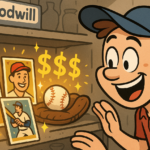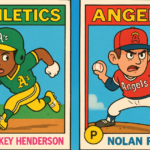Last Updated on October 1, 2024 by Matt Musico
Unlike some of the other MLB home run leaderboards we’ve already looked at so far, the single-season White Sox home run leaders edition hasn’t had any new entrants since 2006. Also, the current leader reached the top of this list before the new millennium.
So, which sluggers have found their way onto this leaderboard? Check out below, and once you’ve done that, see how this compares to the Chicago White Sox’s all-time list.
Related: A Complete Guide to Single-Season (& Single-Game) HR Performances
White Sox Home Run Leaders: Top 5
Albert Belle: 49 Home Runs in 1998

Albert Belle spent just two years with the White Sox. But my goodness, the dude made both of those years count. After slugging 30 home runs with 116 RBI in 1997, he set the franchise single-season record in 1998 with 152 RBI. Belle also watched his OPS improve from .823 in 1997 to 1.055 (!) in 1998. His wRC+ also went from 113 to 165, while his fWAR went from 1.9 to 7.1.
That’s just a little bit of a jump, I’d say.
Stunningly, he didn’t lead baseball in either home runs or RBI. That’s what happens when you go on a power binge during the Great Home Run Chase between Mark McGwire and Sammy Sosa. His 49-homer output was the seventh straight season in which Belle slugged at least 30. That streak would reach eight years the following season by mashing another 37 taters for the Baltimore Orioles in 1999.
He ripped off a 31-homer performance following the All-Star break, which is just insane to think about. He slugged 16 dingers in July. That was followed by hitting a combined 16 between August and September to land on the above number.
Jermaine Dye: 44 Home Runs in 2006
Jermaine Dye enjoyed some solid performances during his 14-year MLB career. None were better than what he accomplished in 2006. He earned his second and final All-Star Game selection while eventually setting single-season career-high marks for homers (44), RBI (120), slugging percentage (.622), OPS (1.006), and wRC+ (151).
Dye accumulated just 3.0 fWAR during this campaign, which was far from his career-best performances (4.2 in 1999 and 2000). In his age-32 season, Dye’s defense was horrid enough to dampen his overall value. But he still placed fifth in AL MVP voting.
Who knows where he would’ve finished if he didn’t have a rough September — at least, it was rough when compared to the rest of his season. Dye’s first five months included four instances of producing an OPS greater than 1.000.
In July and August, he combined for 19 home runs and 51 RBI. August didn’t produce his highest monthly OPS, but it was his best overall performance when looking at his full body of work. In 118 plate appearances, the outfielder slashed .355/.390/.682 with 10 homers and 30 RBI. He finished the year with five homers, 13 RBI, and .835 OPS in September.
Dye’s performance is still a single-season franchise record for right-fielders.
Frank Thomas: 43 Home Runs in 2000

We’ll soon see that Frank Thomas is heavily featured here, which makes sense since he’s the all-time home leader in Chicago White Sox history. Probably the most astonishing fact about Thomas is that while he’s a first-ballot Hall of Famer and collected five seasons of 40-plus home runs, he never led the league in that category. The same could also be said about winning a single-season RBI title.
So, with his two AL MVP awards, he has twice as many MVP awards as he does home-run and RBI crowns. Combined. That’s baseball, baby.
Although his .328/.436/.625 line was bested during other seasons in his career, his 43 home runs and 143 RBI collected in 2000 were both single-season career-high marks. He also nearly won his third MVP, placing second behind Jason Giambi by 32 points. Thomas’ performance was also notable because of the two years he encountered on either side. In 1999, he slugged just 15 home runs in 590 plate appearances. He hit just four in 79 plate appearances in 2001.
The Big Hurt was excellent in most situations during the 2000 season. However, it was clear he preferred hitting at home. Away from the South Side, he posted a .923 OPS. This pales in comparison to the 1.199 mark he produced in Chicago. The same is true in the power department — 30 (!) of his 43 homers came while playing in front of the hometown fans.
Jim Thome: 42 Home Runs in 2006
I remember Jim Thome racking up service time as a member of the White Sox, but I’m still a little shocked after looking at his stats. He was there from 2006 through most of 2009 (he finished that year with the Los Angeles Dodgers) and hit at least 20 homers each year. For the three full years he spent there from 2006-08 — in which he was in his mid-to late-30s — Thome racked up at least 30 taters each time.
Whether it was from the standpoint of his triple slash, fWAR, wRC+, or any of his counting stats, his first campaign in 2006 was his best work for Chicago. It was his sixth and final season of 40 home runs, as well as his ninth and final season of 100-plus RBI.
Thome laid the groundwork for his last 40-homer performance in the first two months of the season. He slugged 10 homers in both April and May, posting an OPS greater than 1.000 both times. While his OPS would surpass that number two more times over the final four months, he hit more than six homers just once (eight in July).
Frank Thomas: 42 Home Runs in 2003

Here’s that man again, and this isn’t the last we’ll be hearing from him, either. Thomas enjoyed 11 different seasons with at least 20 home runs and 100 RBI. The 2003 season was the second-to-last time he reached both of those benchmarks, and it was the final time he surpassed the 40-homer plateau.
Similar to his 2000 campaign, Thomas did more of the same when looking at his home/road splits. He posted a 1.064 OPS with 29 home runs and 64 RBI at home, compared to a .833 OPS, 13 home runs, and 41 RBI on the road in a comparable number of plate appearances. The slugger also took advantage of facing left-handed pitchers, as 17 of his 42 dingers came in this situation despite racking up just 184 plate appearances against southpaws.
White Sox Home Run Leaders: The Rest
Here’s the remainder of the top-20 most powerful home-run-hitting seasons in White Sox history:
- Frank Thomas, 1993: 41 home runs
- Adam Dunn, 2012: 41
- Paul Konerko, 2004: 41
- Frank Thomas, 1995 and 1996: 40
- Paul Konerko, 2005: 40
- Todd Frazier, 2016: 40
- Paul Konerko, 2010: 39
- Luis Robert Jr., 2023: 38
- Frank Thomas, 1994: 38
- Magglio Ordonez, 2002: 38
- Dick Allen, 1972: 37
- Carlton Fisk, 1985: 37
- Jose Abreu, 2014: 36
- Carlos Quentin, 2008: 36
Check out the rest of Chicago’s powerful seasons by heading over to FanGraphs.
Frequently Asked Questions
Who has the most home runs for the White Sox in a season?
Albert Belle is the White Sox single-season home run king. He slugged 49 in 1998.
Who was the last White Sox player to hit 40 home runs in a season?
Todd Frazier is the last White Sox player to slug 40 homers in a season. He hit that number exactly in 2016.
Want to see the White Sox slug dingers in person? Grab tickets from our friends at Vivid Seats. And before you get to the stadium, make sure you’re decked out in the right gear. Get official White Sox merch from the MLB Shop or a ‘Big Dinger Energy’ shirt from our apparel store.





Leave a Reply